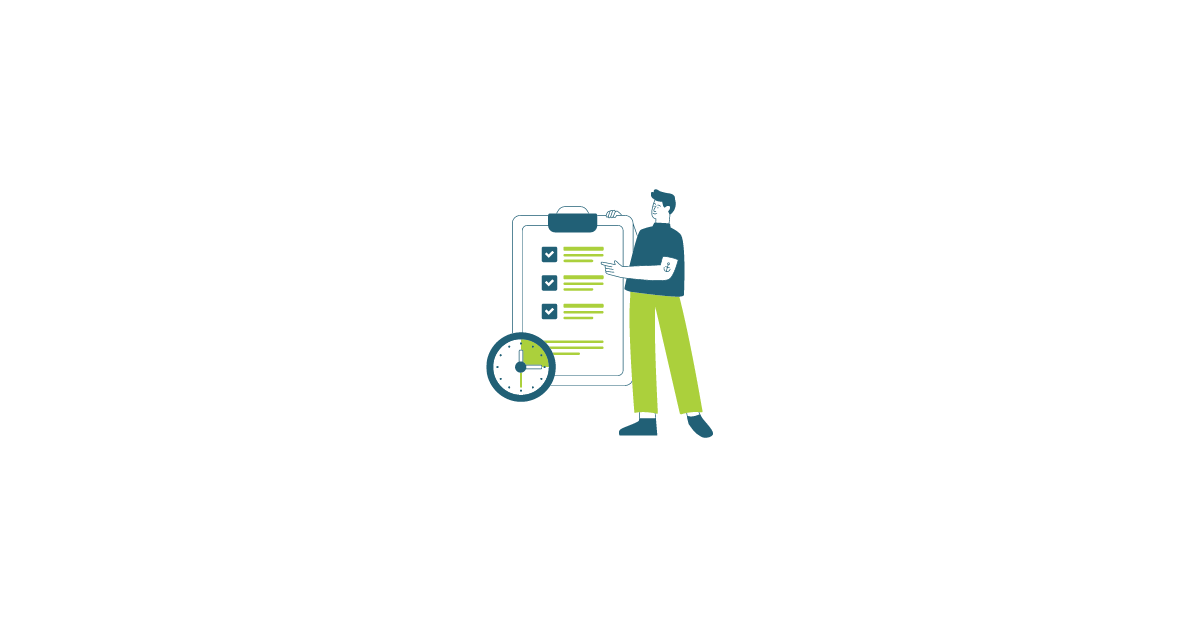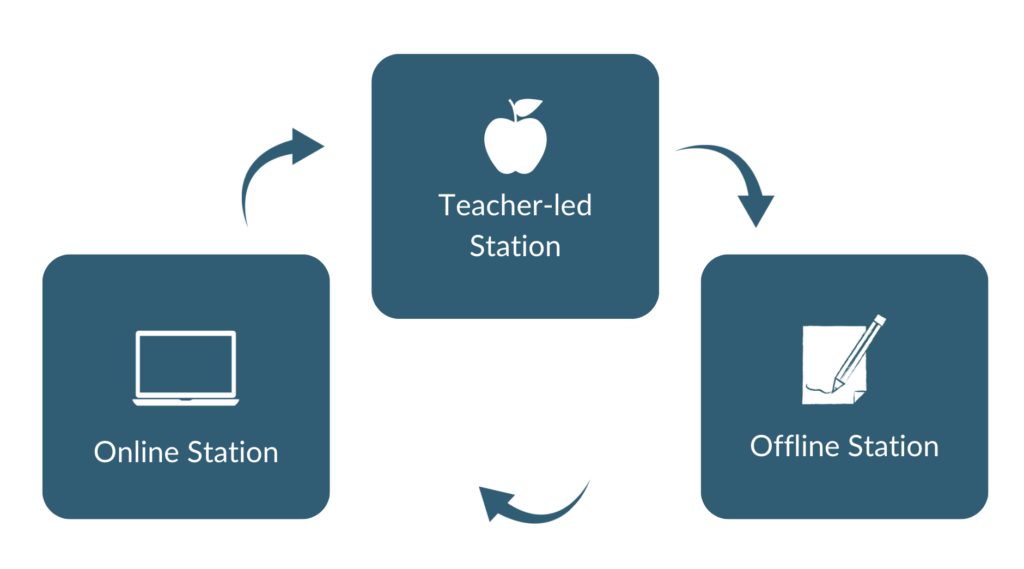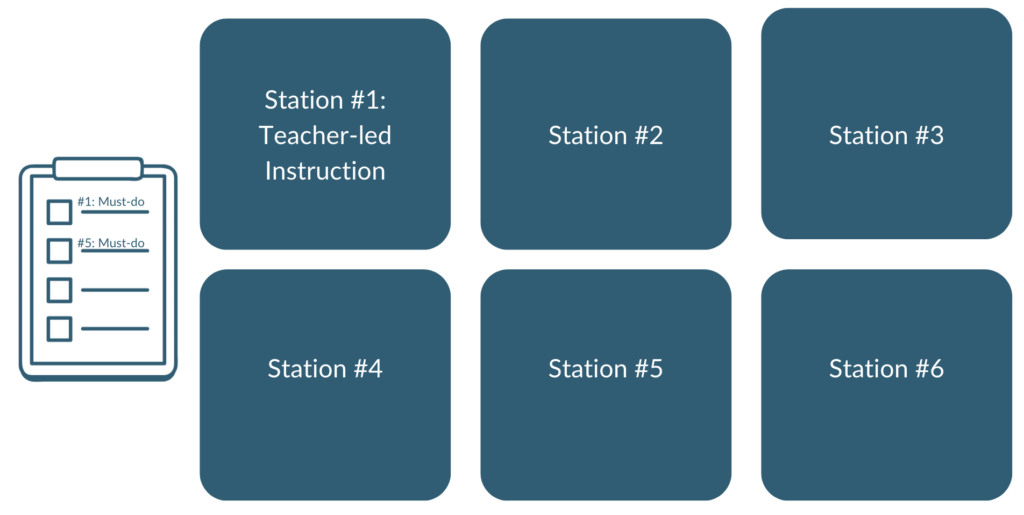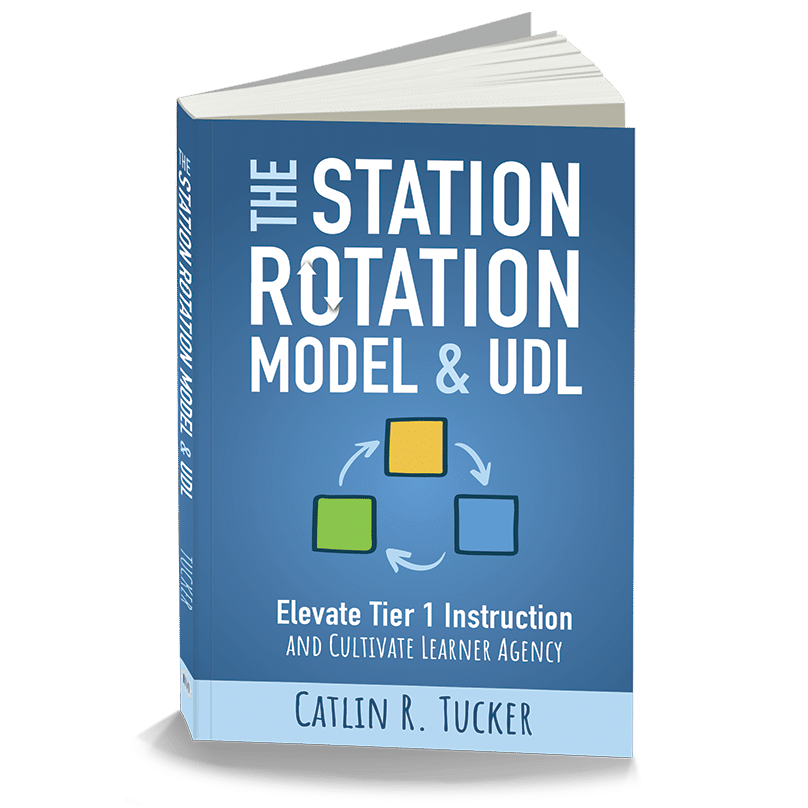Related Podcast Episode
A teacher recently asked me whether students always need to attend every station in a rotation. The short answer is “no.” Our classrooms are composed of diverse groups of students with different skills, abilities, preferences, language proficiencies, and academic needs. Given that variability, it makes sense that not all students would need to spend time engaged in the same learning tasks or activities. So, teachers who love the station rotation model may want to experiment with a fun variation of the traditional design of a rotation.
This twist on the station rotation model combines the strategic collection and use of data with student agency to create a more personalized and student-centered approach to this blended learning model. In a traditional station rotation, all students rotate through the same sequence of learning activities or stations.
Must-do vs. May-do: Targeting Needs & Prioritizing Agency
By contrast, the must-do versus may-do variation of a station rotation requires that teachers use data to identify student needs and design a rotation in which specific students are required to attend one or two “must-do” stations. In addition to these “must-do” stations, students can select a certain number of “may-do” stations to spend time at based on their preferences and interests.
For example, a teacher might design a station rotation with six stations. However, students will only have time to attend four of the six stations in the rotation. So, the teacher will use data to assign each student one or two “must-do” learning activities. These are the stations they must attend in the rotation. Once students have attended their “must-do” stations, they can decide which other “may-do” stations are appealing because they align with the student’s interests and preferences or target a concept or skill they want to spend time on.
When Should Teachers Use This Strategy?
As educators, we always look for ways to enhance our students’ learning experiences, making them more engaging and effective. With its blend of mandatory and elective stations, the modified station rotation model offers a powerful tool for personalized learning. But when is it most beneficial to implement this variation?
Differentiated Learning Needs: In a class with diverse skill levels, a teacher uses assessment data to identify critical areas where individual students need extra support. Must-do stations are tailored for skill reinforcement, while may-do stations offer extension activities, review games, and metacognitive skill-building activities.
Interest-Based Learning: In a unit of study, a teacher sets up must-do stations addressing core curriculum requirements and may-do stations that invite students to delve into subtopics related to the subject, allowing students to choose based on their interests and passions.
Preparation for an Assessment: To prepare for upcoming tests or assessments, must-do stations provide practice and support in areas where data shows students struggle. In contrast, may-do stations offer practice in areas where students feel they can benefit from additional practice and review.
Math Skills Reinforcement: For math classes, must-do stations could focus on foundational math skills that need reinforcement, as identified by assessment data, while may-do stations could offer problem-solving activities, collaborative real-world math challenges, or math games that stimulate critical thinking and application.
Language Acquisition: In language classes, must-do stations target specific speaking, grammar, vocabulary, and writing skills that need improvement, while may-do stations provide opportunities for conversational practice, engagement with media to improve comprehension skills, or cultural exploration.
Project-Based Learning (PBL): In a PBL environment, must-do stations could be essential steps in the project process, such as research or prototype development, while may-do stations offer optional skills workshops or resources for deepening project work, like using organizational project management tools or conducting interviews.
Collecting Data to Inform “Must-do” Stations
The effectiveness of this approach to the station rotation model hinges on accurately identifying the “must-do” stations for each student. This process begins with collecting and analyzing data to pinpoint individual learning needs and strengths.
Formative Assessment Data: Regular formative assessments can provide immediate feedback on student understanding and mastery of specific skills. These formative assessments can take the form of quizzes, short written responses, exit tickets, online discussions, and graphic organizers.
Summative Assessment Data: When students complete a summative assessment, that data often reveals that the class is in different places in terms of their concept knowledge and skill set. Instead of moving on to the next unit of study, teachers can pause and design a must-do versus may-do station rotation to address specific areas of need that surfaced from the summative assessment data. This gives the teacher time to address gaps or misconceptions before starting a new unit.
Once teachers have used data to identify specific areas of need, they can assign each student one or two “must-do” stations.
Communicating “Must-do” Stations to Students
Logistically, teachers can use a few strategies to communicate with students about which stations are “must-do” during a rotation.
Digital or Printed Learning Plans: Provide students with digital or printed learning plans that detail their must-do stations for a station rotation lesson. These can include checkboxes or spaces for stamps/stickers to mark completion, helping students track their progress.
Color-Coded Systems: Use color-coded cards or folders to signify different stations. Each student receives cards or folders indicating their must-do stations at the beginning of class.
Personalized Station Maps: Give each student a “map” of the classroom with their must-do stations highlighted or marked. This map can be paired with a personal itinerary or schedule outlining the times or order for visiting each station.
My favorite strategy is to give students a blank personalized learning plan, like the one pictured below, and pass out color-coded cards that signify specific stations. This allows teachers to quickly communicate the “must-do” stations to students and reuse those blank colored cards for future may-do versus must-do station rotations.
Teachers can quickly distribute the cards to individual students during the welcome activity or warm-up. When they receive the colored cards, students can fill in their “must-do” on their individual learning plans. This reduces the time teachers spend preparing for this lesson and encourages students to participate actively in the planning process.

Wrap Up
The “must-do” versus “may-do” approach to station rotation combines structured, data-driven tasks with flexible, interest-based activities, striking a balance between needs-based learning and student agency. The “must-do” stations ensure that essential skills and knowledge gaps are addressed, while the “may-do” stations invite students to explore their interests and passions, promoting higher levels of engagement and motivation.
Implementing this model requires thoughtful planning and a deep understanding of each student’s needs and preferences. Whether leveraging high-tech platforms for seamless communication and tracking or utilizing low-tech methods for organizing and managing stations, the focus remains on creating a student-centered learning environment. Ultimately, this approach enhances academic outcomes and empowers students to take ownership of their learning journey.
As educators, our mission is to prepare students for success in an ever-changing world. By adopting the “must-do” versus “may-do” station rotation model, we tailor the educational experience to fit the unique needs of each learner, ensuring that every student has the opportunity to thrive and excel.
The Station Rotation Model and UDL: Elevate Tier I Instruction and Cultivate Learner Agency is available now! I’d love for you to check it out, share it with a colleague, and let me know what resonates most with you. If you have any questions about the book, please post a comment!
School leaders interested in using the book for a staff-wide study can place a discounted bulk order for 10 or more copies. If you and your teachers need additional support, I offer customized professional learning that is hands-on, practice-based, and tailored to your team’s needs. Together, we can support your teachers in developing their UDL practice, differentiating instruction more effectively, and elevating Tier 1 instruction. We can even utilize the Station Rotation Model to create space for Tier 2 support and Tier 3 intervention within general education classrooms. And, we can explore how this model can help us position students as active agents leading their own learning!







4 Responses
I graduated in December at Old Dominion University.In January I got hired as a kindergarten teacher. I am looking for advice in how to make my centers a)with an easier transition between centers and b) centers that enhance differentiation of learning. Any tips or material you can throw my way.Thank you.
Sincerely,
A new teacher
First of all, congratulations on your first year of teaching! Below are some strategies to help with both transitions between centers and differentiating learning within them.
Young learners thrive on clear routines, visual supports, and movement-based transitions. Here are some key ways to make transitions between centers easier:
1. Use a Consistent Signal – Choose a signal that lets students know when it’s time to transition. This could be a chime or bell, a clap pattern that students repeat back, a song or chant (e.g., “1-2-3, eyes on me!”), or a timer with a visual countdown.
2. Practice & Model Transitions – Set aside time to explicitly teach and practice transitions at the start of the year and after breaks. Model what a successful transition looks like and practice with students.
3. Assign Station Buddies or Partners – Have students transition with a buddy so they can support each other in moving efficiently.
4. Use Color-Coded or Numbered Groups – Assign students a color, shape, or number for their group and have matching signs at the centers to help them quickly locate where they should go next.
5. Build in Movement or Brain Breaks – If students are losing focus, use a quick movement transition (e.g., “hop like a bunny to your next center” or a quick stretch before switching).
Whichever strategy you use, have fun with it but be consistent!
Differentiation in centers can help all learners access and engage with content at their level. Here are some ideas to make differentiation manageable:
1. Adjust the Content (What Students Learn)
Leveled activities allow students to work at varying levels of difficulty. For example, some students may focus on letter recognition while others blend CVC words.
Task cards with different challenges can be color-coded or picture-coded to provide varying levels of support, ensuring students work on tasks that meet their needs.
2. Adjust the Process (How Students Learn)
Choice boards give students 2-3 options to practice the same skill in different ways.Flexible grouping allows students to rotate between working in mixed-ability or similar-ability groups, depending on the task. For example, a teacher-led group may support those who need more direct instruction. Multi-sensory learning engages different learning styles by incorporating hands-on activities like play dough letters or tapping out sounds with counters.
3. Adjust the Product (How Students Show What They Know)
Provide students with different ways to demonstrate their understanding. They might draw and label a picture, verbally explain their thinking to a partner, or build words with letter tiles.
4. Adjust the Support (How Much Help They Receive)
A teacher-led small group station provides direct support for students who need additional guidance with particular concepts or skills.
Start simple and build up to more complex routines. Establishing strong transitions first will allow for more effective differentiation over time. Make small adjustments based on what works best for your students! Good luck with your new teaching assignment!
Best,
Catlin
I love your response! I am always learning. How many rotations are in your classroom? We are being asked to have rotations while we teach UFLI or a similar skills group lesson. Are you teaching specific groups during this time as well? Would you be willing visuals that you have in your classroom?
Hi Amy,
The number of rotations will vary depending on your schedule. In a traditional 50-minute class period, you’ll likely have time for about three rotations. If you’re on a block schedule, you may be able to facilitate four or even five rotations, depending on how much time students need at each station to meaningfully engage with the work.
When I’ve facilitated a must-do vs. may-do station rotation, I always lead a teacher-led “skills” station. Each rotation focuses on a different skill, allowing me to work with small groups and target specific gaps or areas of need that surface in the data.
I do have photos of students working during a must-do vs. may-do lesson, but visually, it looks very similar to a traditional station rotation. Most of the variation with this model happens behind the scenes—using data to determine the must-do stations for each student, providing them with a station tracker so they know where to go, and building in time for them to engage with both required and optional learning tasks.
Best,
Catlin